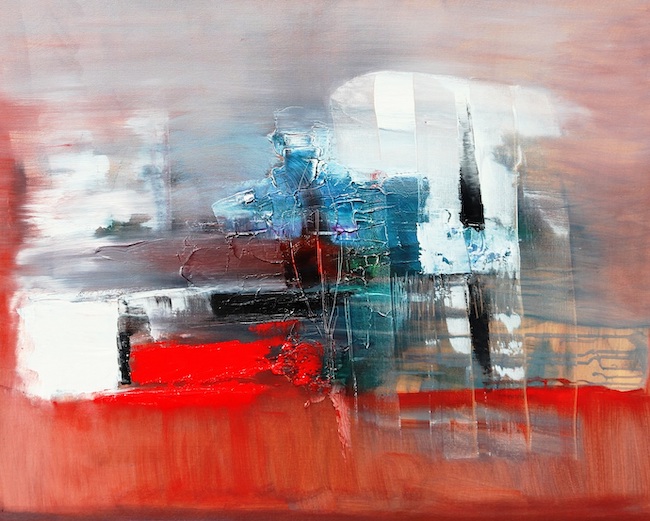Nell’epoca contemporanea, tanto veloce e perfetta nella forma da indurre a dimenticare di fermarsi per ascoltare un’interiorità che invece non può e non vuole correre perché ha bisogno di manifestarsi in maniera più introspettiva e moderata, l’espressione artistica diviene a volte il mezzo attraverso il quale quelle profondità vengono svelate, interpretate attraverso i colori e raccontate all’osservatore che non può fare a meno di sentirsi avvolto e coinvolto da quelle emozioni tanto simili alle proprie. L’artista di cui vi racconterò oggi ha la particolare capacità di trovare una terra di mezzo tra tutto ciò che si nasconde e dunque può rivelarsi solo attraverso l’intuizione, e ciò che invece illude lo sguardo prendendo le sembianze di qualcosa di conosciuto mentre invece è solo complemento dell’interpretazione dell’interiorità.
Agli inizi del Novecento, quel burrascoso periodo creativo durante il quale tutto ciò che era accademicamente certo e ben delineato venne sovvertito, messo in discussione, analizzato alla luce di nuove idee espressive e di un inedito modo di ripensare la manifestazione artistica, furono molti i movimenti pittorici che si imposero di superare gli schemi e i dogmi precedenti per esplorare nuove strade, nuovi modi possibili per aprire un dialogo differente tra esecutore e fruitore dell’opera. A partire dal Divisionismo, dove ancora il legame con la realtà osservata era molto forte, si è andati verso una progressiva scomposizione dell’immagine che ha condotto in una parte d’Europa verso il Futurismo e il Cubismo, da un’altra invece verso un rifiuto della figurazione per tendere verso la completa astrazione. L’artista considerato il fondatore dell’Astrattismo fu Vassily Kandinsky che arricchiva le sue opere di forme immaginarie quasi danzanti illudendo lo sguardo di trovarsi davanti a qualcosa di già visto salvo poi realizzare l’impalpabilità delle figure narrate, la loro appartenenza al mondo del sogno, del non reale eppure in grado di far vibrare le corde emotive. L’ambizioso intento espressivo di Kandinsky era di interpretare la musica, il rapporto tra sensazioni e vibrazioni armoniche che entra in gioco nel momento in cui la parte razionale viene lasciata indietro e messa in posizione secondaria rispetto all’interiorità. Parallelamente alla sua manifestazione artistica si delineò nella vicina Germania, la ricerca pittorica di un altro grande esponente dell’Astrattismo, Paul Klee, molto più legato all’immagine che però riduceva nei dettagli stilizzandola e rendendola impalpabile lasciando che fosse l’emozione del fruitore a condurlo verso un riconoscimento di quei paesaggi appartenenti a un mondo immaginario, fanciullesco, eppure in grado di conquistare lo sguardo dell’adulto che all’interno di quei luoghi fiabeschi si perde. Anche nel caso di Klee il legame con la musica era essenziale per generare un collegamento tra espressioni artistiche diverse eppure incredibilmente connesse proprio in virtù della capacità di entrambe di interagire e di generare un’atmosfera avvolgente e magica laddove i colori, la rarefazione dell’immagine, sono interpretazione delle note musicali che elevano le emozioni verso un universo superiore, piacevole e più morbido rispetto alla durezza della realtà. È esattamente in questa dimensione che si collocano le opere di Avdia Van Art, artista di origini rumene da anni residente ad Anversa in Belgio, in uno stile a vicino alla rarefazione di Klee pur mostrando un’impronta decisamente personale sia nella scelta della gamma cromatica, sia nella molteplicità dei soggetti che variano sulla base della sensazione di cui desidera parlare, del frammento di immaginazione o di ricordo in cui si trova immersa quando si siede davanti alla tela bianca.
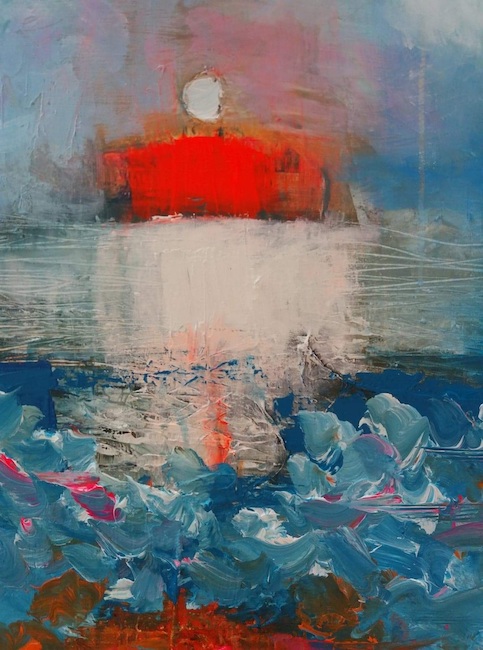
Una delle tematiche che emerge in maniera più costante è quella del viaggio inteso come migrazione perché per lei che ha scelto di lasciare il suo amato paese d’origine e la sua famiglia per inseguire il suo sogno artistico, è importante sottolineare quella sottile nostalgia nei confronti di un passato, del luogo dove si è nati e cresciuti e verso cui l’anima e il cuore inevitabilmente tendono, malgrado la distanza, o forse proprio per essa.
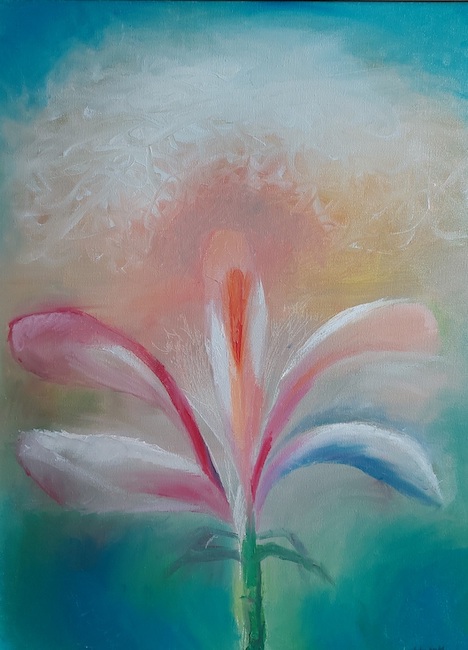
Lo stile pittorico di Avdia Van Art si avvicina all’Astrattismo Lirico per la leggerezza impalpabile delle atmosfere narrate, un misto di magia e armonia in cui emerge la positività sorridente così come la delicatezza interiore con cui l’artista osserva il mondo intorno a sé quasi come se fosse costantemente avvolto da una colonna sonora emozionale, da note musicali che diventano sfumature cromatiche e che accompagnano la profondità del sentire verso la consapevolezza del manifestarsi all’esterno, del liberarsi per cercare un dialogo con la natura circostante e tutto ciò che accade e che giunge a coinvolgere le emozioni.
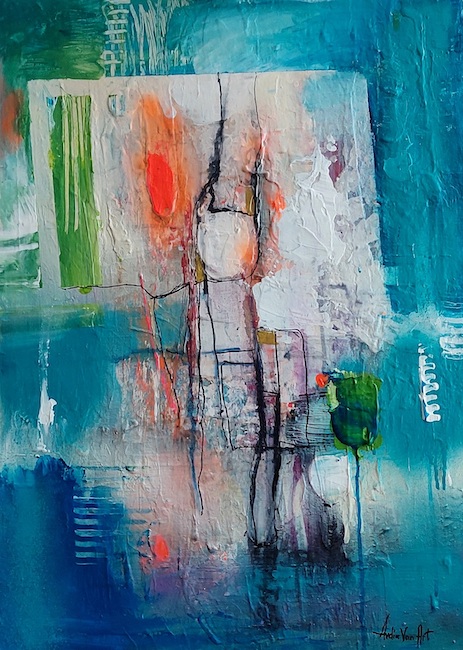
Anche nelle sue opere, come quelle di Klee e di Kandinsky, lo sguardo viene ingannato attraverso dettagli che riconducono a qualcosa di già visto, di conosciuto, dunque inizialmente c’è un avvicinamento razionale, ma poi quell’apparente figurazione si perde e comincia un processo di consapevolezza differente, un approfondimento che rompe i confini della mente e della logica e va verso l’indefinito dell’emozione, delle sensazioni in cui il fruitore viene coinvolto lasciandosi avvolgere da quell’equilibrio melodico in cui tutto ciò che ha bisogno di fare è farsi trasportare dal proprio mondo interiore ed entrare in connessione con l’opera.
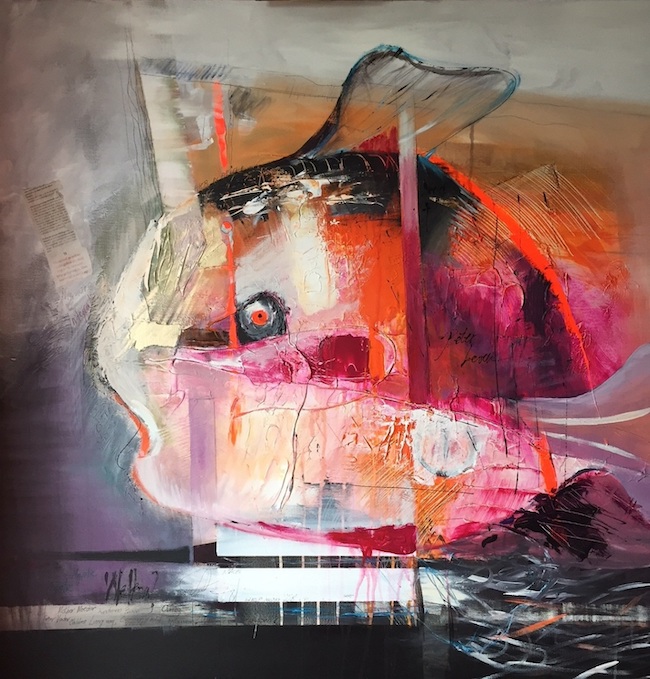
Nella tela De vis (Onirico) questa sovrapposizione di realtà e di irrealtà è molto evidenziata poiché lo sguardo, quel piccolo occhio al centro della composizione, appartiene a un pesce i cui bordi si sfumano, divengono impalpabili, si vanno a confondere con lo sfondo che non rappresenta il mare, che costituirebbe il suo ambiente naturale, bensì appare come un luogo diverso, forse ideale per l’animale, metafora dell’essere umano il quale spesso è costretto, oppure sceglie, di uscire dalla propria zona sicura, collocandosi dunque allegoricamente fuori dalla sua acqua, per inseguire un destino diverso, un sogno che, restando dove sembra destinato a stare, non potrebbe mai realizzarsi. La gamma cromatica in scala di rosa mista ad arancioni e sfumature che vanno verso il bianco, sembra rappresentare la vivacità e la speranza che quel nuovo habitat genera.
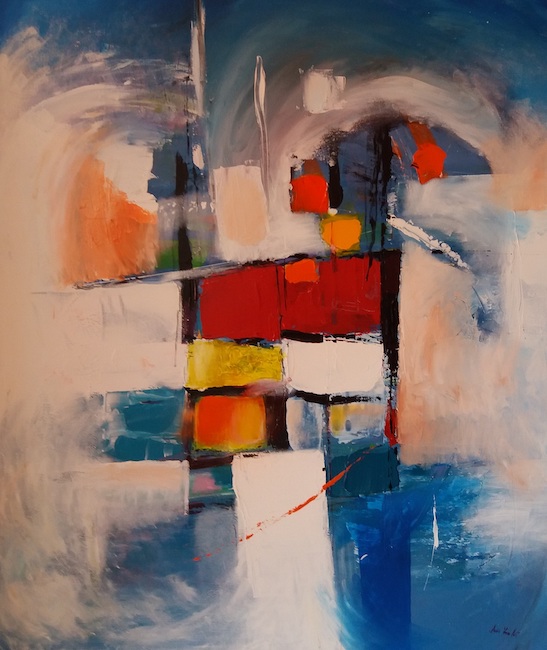
Nel lavoro Abstract 2 Avdia Van Art riprende la lieve figurazione di Klee pur non dando una sembianza così definita come usava fare il maestro del Novecento eppure la gamma cromatica è invece più decisa, più intensa perché affine a un sentire diverso, necessitante di fluire all’esterno con l’entusiasmo e l’esuberanza con cui lei stessa affronta e vive le sensazioni di cui si fa interprete e che non possono non giungere alle vibrazioni emozionali dell’osservatore. Tuttavia nonostante la definizione dei colori scelti, i contorni sono sfumati, sono indefiniti a sottolineare quanto anche nella realtà tutto possa essere relativo, possa trovare dei risvolti differenti sulla base del punto di osservazione.
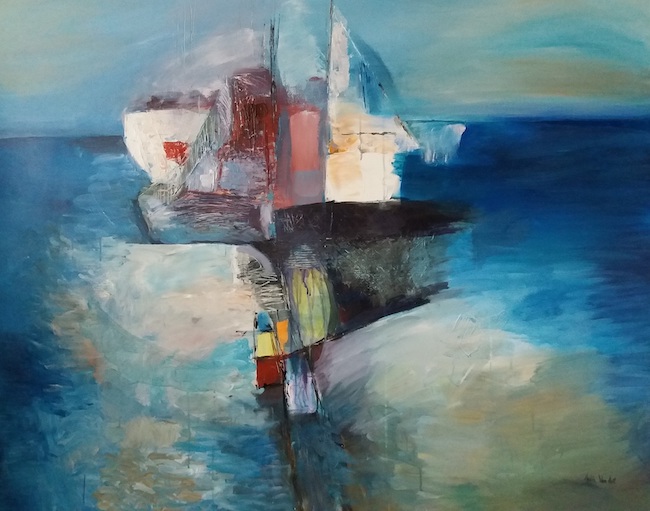
E ancora in On the see (Sul mare) l’artista riprende il tema del viaggio, impossibile capire se sia di allontanamento o di arrivo, avvolgendolo di atmosfera intensa, suggestiva proprio perché uno spostamento, in questo caso della barca nel mare, sottintende sempre una scoperta, una connessione con culture diverse, con possibilità nuove e inaspettate sia che si tratti di un trasferimento temporaneo sia che invece quello spostamento sia una scelta di vita, proprio la stessa che Avdia Van Art ha compiuto. Le vele sono tratteggiate, appena accennate eppure evidenti nella parte superiore, quella del presente con tutte le sue incognite, mentre sembrano più delineate nella parte inferiore, quella del riflesso che si collega alla memoria di tutto ciò che viene lasciato alle spalle; ecco il motivo per cui i colori sono più vividi e vivaci, perché rappresentano un vissuto reale, qualcosa di già conosciuto che appartiene al bagaglio emotivo e che avrà sempre un posto speciale nell’interiorità. Anche in questa tela l’impalpabilità dell’ambiente circostante contribuisce a infondere la magica suggestione che appartiene alla produzione di questa brava artista rumena.
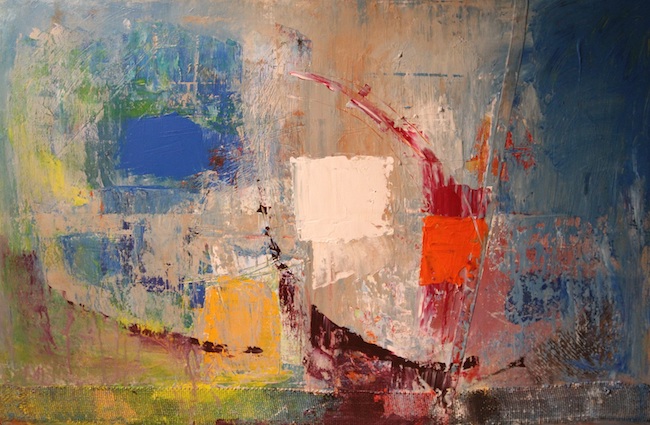
Avdia Van Art ha all’attivo più di quaranta mostre in Belgio, Regno Unito, Germania e Romania, e le sue opere fanno parte di colleziono private in Belgio e all’estero.
AVDIA VAN ART- CONTATTI
Email: avdia.avrumutoae@gmail.com
Facebook: https://www.facebook.com/avdia.vanart1
Instagram: https://www.instagram.com/avdiaavrumutoae/
Avdia Van Art’s Abstractionism, figuration hidden in abstraction to listen to the naturalness of the human soul
In our contemporary age, so fast and perfect in form that we forget to stop and listen to an interiority that cannot and does not want to run because it needs to manifest itself in a more introspective and moderate manner, artistic expression sometimes becomes the means by which those depths are revealed, interpreted through colour and told to the observer who cannot help but feel enveloped and involved by those emotions so similar to his own. The artist I am going to tell you about today has the particular ability to find a middle ground between everything that is hidden and therefore can only be revealed through intuition, and that which deludes the eye by taking on the appearance of something known when in fact it is only a complement to the interpretation of interiority.
At the beginning of the twentieth century, that stormy creative period during which everything that was academically certain and well defined was subverted, questioned, analysed in the light of new expressive ideas and an unprecedented way of rethinking artistic expression, there were many pictorial movements that set out to overcome previous schemes and dogmas to explore new paths, new possible ways of opening up a different dialogue between the executor and the viewer of the artwork. Starting with Divisionism, where the link with observed reality was still very strong, there was a progressive decomposition of the image that led in one part of Europe towards Futurism and Cubism, and in another part towards a rejection of figuration and a move towards complete abstraction. The artist considered to be the founder of Abstractionism was Vassily Kandinsky, who enriched his artworks with imaginary, almost dancing forms, cheating the eye into thinking it was looking at something it had already seen, but then realising the impalpability of the figures depicted, their belonging to the world of dreams, of what is not real and yet capable of vibrating the emotional chords. Kandinsky’s ambitious expressive intent was to interpret music, the relationship between sensations and harmonic vibrations that comes into play when the rational part is left behind and placed in a secondary position with respect to interiority.
Parallel to his artistic manifestation, in neighbouring Germany, the pictorial research of another great exponent of Abstractionism, Paul Klee, took shape. He was much more tied to the image, which he reduced in detail, stylising it and making it impalpable, allowing the viewer’s emotions to lead him towards a recognition of those landscapes belonging to an imaginary, childlike world, yet capable of conquering the gaze of adults who lose themselves in those fairytale places. In Klee’s case, too, the link with music was essential in order to generate a connection between artistic expressions that are different yet incredibly connected precisely because of the ability of both to interact and to generate an enveloping, magical atmosphere where the colours, the rarefaction of the image, are interpreted by the musical notes that elevate the emotions towards a superior universe, pleasant and softer than the harshness of reality. It is precisely in this dimension that the artworks of Avdia Van Art, an artist of Romanian origin who has lived in Antwerp in Belgium for many years, are placed. Her style is close to Klee’s rarefaction while showing a decidedly personal imprint both in the choice of the chromatic range and in the multiplicity of subjects which vary according to the sensation she wishes to talk about, the fragment of imagination or memory in which she finds herself immersed when she sits in front of the blank canvas. One of the themes that emerges most consistently is that of travel, understood as migration, because for her, who has chosen to leave her beloved country of origin and her family to pursue her artistic dream, it is important to emphasise that subtle nostalgia for the past, for the place where one was born and grew up and towards which the soul and heart inevitably tend, despite the distance, or perhaps because of it. Avdia Van Art’s painting style is close to Lyrical Abstractionism for the impalpable lightness of the atmospheres narrated, a mixture of magic and harmony in which the smiling positivity emerges as well as the inner delicacy with which the artist observes the world around him almost as if he were constantly enveloped by an emotional soundtrack, by musical notes that become chromatic nuances and that accompany the depth of feeling towards the awareness of manifesting oneself outside, of freeing oneself to seek a dialogue with the surrounding nature and everything that happens and comes to involve the emotions.
Even in her artworks, like those of Klee and Kandinsky, the eye is deceived by details that lead back to something already seen, known, so initially there is a rational approach, but then that apparent figuration is lost and begins a process of different awareness, a deepening that breaks the boundaries of the mind and of logic and goes towards the indefinite of emotion, of sensations in which the viewer is involved, letting himself be enveloped by that melodic equilibrium in which all he needs to do is let himself be transported by his own inner world and enter into a connection with the artwork. In the painting De vis (Onirico), this overlap of reality and unreality is very much in evidence, since the gaze, that small eye in the centre of the composition, belongs to a fish whose edges become blurred, impalpable, blending with the background that is not the sea, which would be its natural environment, it appears to be a different place perhaps ideal for the animal, a metaphor for the human being who is often forced, or chooses, to leave his safe zone, allegorically placing himself outside his water, to pursue a different destiny, a dream which, remaining where he seems destined to be, could never be realised. The chromatic range on a scale of pinks mixed with oranges and shades moving towards white seems to represent the vivacity and hope that this new habitat generates. In the canvas Abstract 2, Avdia Van Art takes up Klee’s light figuration, although she does not give it such a definite appearance as the twentieth-century master used to do, and yet the chromatic range is instead more decisive, more intense because it is akin to a different feeling, needing to flow outwards with the enthusiasm and exuberance with which she herself faces and lives the sensations of which she is the interpreter and that cannot fail to reach the emotional vibrations of the observer. However, despite the definition of the colours chosen, the outlines are blurred, undefined, underlining how everything in reality can be relative, how it can have different implications depending on the point of observation.
And again in On the See, the artist takes up the theme of the voyage, impossible to understand whether it is one of departure or arrival, enveloping it in an intense, suggestive atmosphere precisely because a movement, in this case of the boat in the sea, always implies a discovery, a connection with different cultures, with new and unexpected possibilities, whether it is a temporary move or a life choice, the very one Avdia Van Art has made. The sails are outlined, barely hinted at but evident in the upper part, that of the present with all its unknowns, while they seem more outlined in the lower part, that of the reflection which is linked to the memory of all that is left behind; this is why the colours are more vivid and bright, because they represent a real experience, something already known which belongs to the emotional baggage and will always have a special place in the interiority. In this canvas too, the intangibility of the surrounding environment contributes to the magical charm of this talented Romanian artist’s work. Avdia Van Art has had more than forty exhibitions in Belgium, the United Kingdom, Germany and Romania, and her works are part of private collections in Belgium and abroad.


